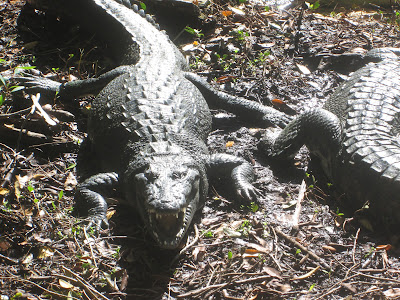Friends and I recently visited Rio Lagartos, the name of both a town and a UNESCO Biosphere Reserve in eastern Yucatan. The Spanish name means "Alligator River," but as Ismael Navarro, owner of Yucatan Ecotours, told us, there is no river and there are no alligators here. The body of water along which this little town sits is an estuary of the Gulf of Mexico, with relatively little fresh water,
(If I had been a sixteenth-century explorer, I would not have wanted to get close enough to tell the difference, either. These creatures have serious teeth.)
To norteamericanos, the reserve is perhaps best known as a nesting site for flamingos, but the area has been inhabited by humans for a long time. Ismael and his son Angel, who was our guide for a fabulous boat tour through a variety of ecosystems, gave a bit of the human history along with outdoor education. The Maya named what is now Rio Lagartos hol k’óoben-"entry to the kitchen"--or literally the three stones marking the boundaries of a cooking fire. The nearby salt lagoons supplied much of this part of the peninsula, and the Gulf and the estuary teem with fish and other marine life even today. Isla Cerritos, now a nesting area for birds, was the fortified site from which the Maya of Chichén Itzá controlled the trade routes for salt and other valuable substances. This sleepy little town was an important place.
And it still is. Besides flamingos and crocodiles, the biosphere reserve is home to dozens of species of mammals, reptiles, amphibians, and nearly 400 species of birds. (No one seems to have counted the insect species, but there are lots of them.) Endangered loggerhead sea turtles nest here, as do magnificent frigatebirds and wood storks, which in my Florida girlhood were nearly extinct.
Wood stork photo courtesy of Kate Fitzgerald
And while we did not get to the nesting colonies, we did see a couple of quite handsome flamingos.
A particular delight for our little group is the fact that so many people in the village have embraced ecotourism. Nature guiding seems to be a growth industry here, with local young people learning the rich natural and cultural heritage of their region--and graciously sharing it with those of us lucky enough to visit.






1 comment:
Whst an inviting description, Rebecca! Such a trip is a blessing!
Post a Comment